PSQF:2115 (Intro to Counseling Psychology) Final Exam
1/193
There's no tags or description
Looks like no tags are added yet.
Name | Mastery | Learn | Test | Matching | Spaced |
|---|
No study sessions yet.
194 Terms
What are the different waves of therapy?
1st Wave: Psychoanalysis, psychodynamic
2nd Wave: Behavioral, cognitive-behavioral (CBT)
3rd Wave: Humanistic, existential
4th Wave: Feminist-multicultural, constructivist, integrative
Psychosexual Stages of Development
Oral (birth-1 year)
Anal (1-3)
Phallic (3-6; oedipus complex)
Latent (6-puberty)
Genital (puberty-adult)
What are the three levels of consciousness?
1. Unconscious
2. Pre-conscious
3. Conscious
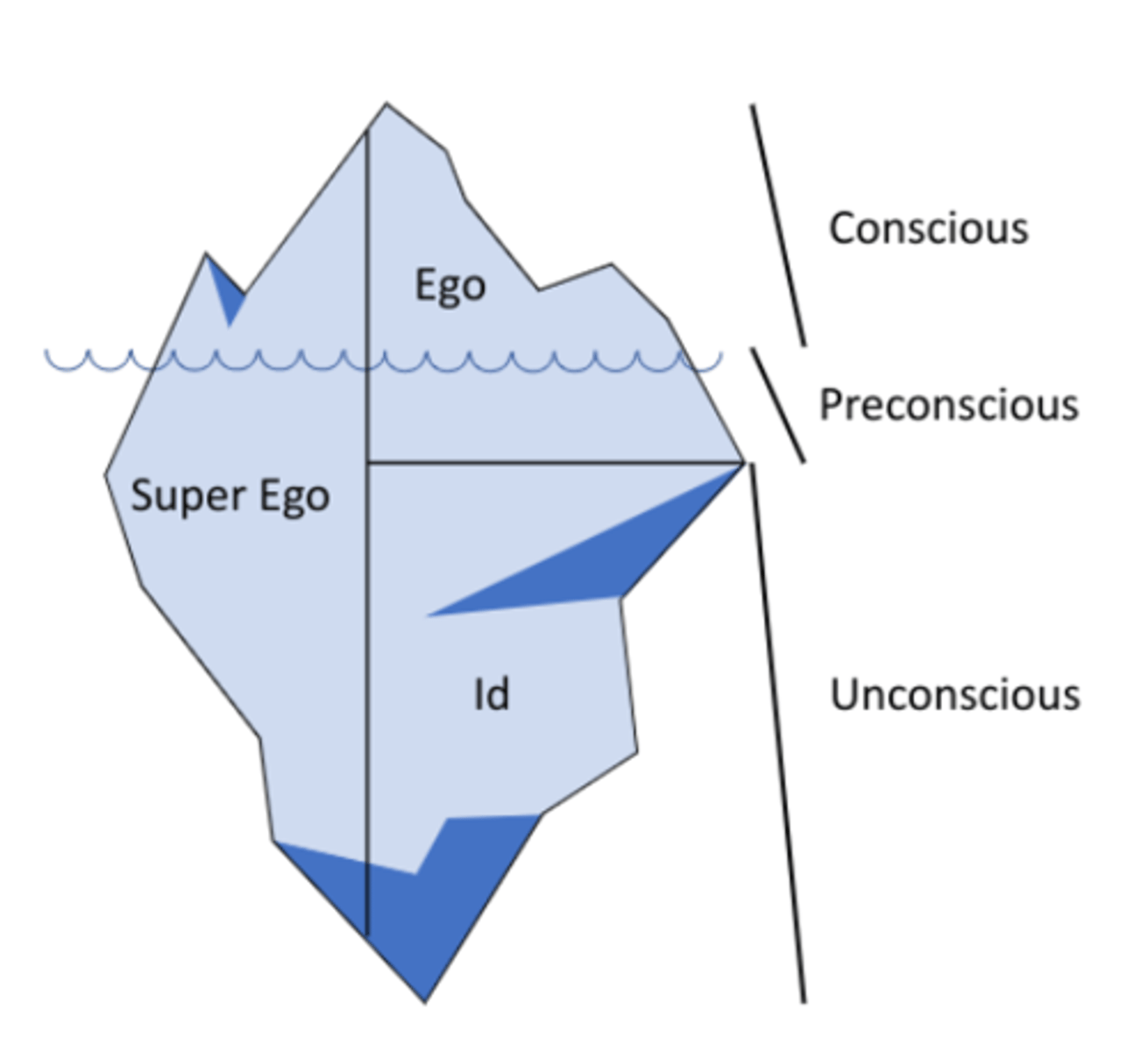
What are the three structures of the mind?
1. Id
2. Ego
3. Superego
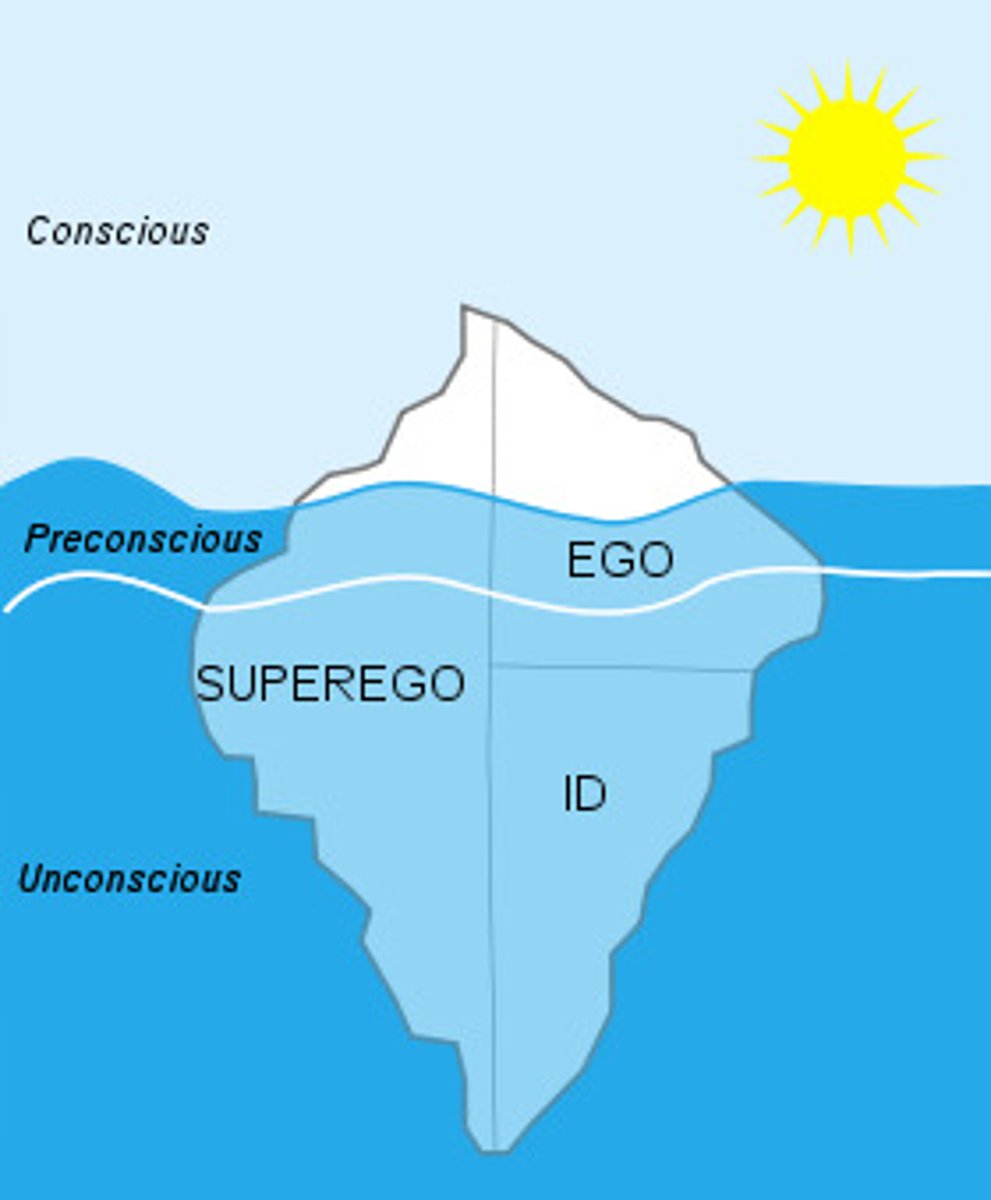
Psychoanalysis
A form of treatment that has certain defining characteristics
How does psychoanalysis proper differ?
1. Treatment length (long-term, open-ended)
2. Treatment intensity (at least 3x per week)
3. Types of interventions
Psychodynamic Therapy
Refers to a broad range of approaches that are based on psychoanalytic theory but lack some defining characteristics of psychoanalysis
Are psychodynamic and psychoanalytic interchangeable?
Yes
Psychoanalysis Proper
Sessions per week: 3-5
Treatment duration: 3-7 weeks
Major techniques: interpretation, free association
Practitioner: psychoanalyst
Psychoanalytically Oriented Therapy
Sessions per week: 1-2
Treatment duration: a few months to years
Major techniques: interpretation
Practitioner: mental health professional
Psychodynamically Informed
Sessions per week: 1
Treatment duration: varies
Major techniques: eclectic/integrative therapy
Practitioner: mental health professional
What are the basic principles of psychoanalytic therapies?
1. Human beings are influenced by wishes, fantasies, and knowledge that are outside of awareness (unconscious)
2. Interest in facilitating awareness of unconscious motivations, increasing choice
3. Emphasis on exploring ways people avoid painful or threatening feelings/thoughts
4. People are ambivalent about change, emphasis on the importance of exploring this ambivalence
5. Use of the therapeutic relationship to explore psychological processes
6. Use of the therapeutic relationship as an important vehicle of change
7. Emphasis on helping clients understand how the ways they make sense of their past and present play a role in perpetuating habitual patterns
Transference
Clients' tendency to view the therapist in terms that are shaped by their experiences with caregivers and other significant figures in their life
Countertransference
The therapist's reaction to the client (feelings, associations, fantasies), which provides potentially valuable information about the client
Defense Mechanisms
Psychological strategies that are used unconsciously to protect a person from anxiety arising from unacceptable thoughts or feelings
Identifying defense mechanisms can be an important part of psychological assessment and can influence the treatment process
We all use defenses
Overuse is related to dysfunction
What are the different types of defense mechanisms?
1. Denial
2. Displacement
3. Intellectualization
4. Projection
5. Rationalization
6. Reaction formation
7. Repression
8. Sublimation
9. Suppression
Denial
Refusing to accept reality
Displacement
Redirecting emotions to a substitute target
Intellectualization
Excessively analytical thought patterns to distance from emotions
Projection
Attributing unwanted feelings/thoughts to others
Rationalization
Coming up with credible but false justifications for thoughts/feelings/actions
Reaction Formation
Replacing an anxiety-producing impulse by the opposite behavior
Repression
Excluding upsetting experiences from conscious awareness
Sublimation
Redirecting unacceptable urges into socially acceptable actions
Suppression
Intentionally avoiding thinking about disturbing wishes, feelings, or experiences
What are the different psychoanalytic techniques?
1. Free association (saying everything that comes to mind without censoring)
2. Use of dreams
3. Interpretation
4. Analysis of transference
All have the goal of helping clients become aware of unconscious aspects of their experience
What did John Bowlby do?
John Bowlby observed orphaned infants after WWII
Concluded that early social attachment between an infant and a caretaker is essential for normal social development
Determined that babies and caregivers have an innate tendency to form an attachment
What did Mary Ainsworth do?
Mary Ainsworth continued Bowlby's research
Attachment to a caregiver differs in the degree of security in the attachment
Differences in security of attachment influence personality and social relationships in infancy and beyond
Attachment is also a behavioral system through which humans regulate their emotional distress when under threat and achieve security by seeking proximity to another person
Attachment Theory
Importance of relationships in dysfunction and health
What are the different attachment styles?
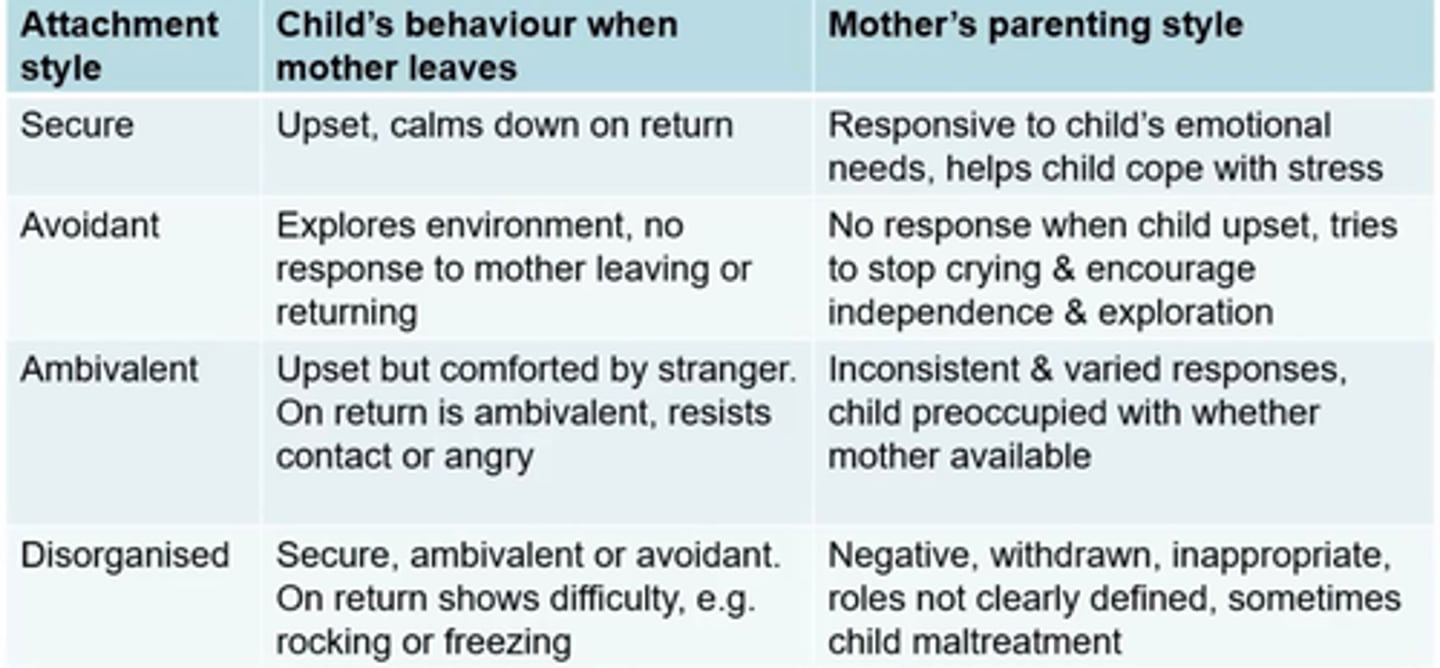
Time-Limited Dynamic Psychotherapy (TLDP)/Brief Psychodynamic Therapy
Theoretical orientation rooted in psychodynamic concepts
Relational model:
Attention is given to relationship patterns rather than a specific problem
Relationship is the central focus of change
Movement away from a one-person psychology to a two-person psychology
Dyadic relationship is the mechanism of change
Short-term therapy process (approximately 20 sessions)
What are TLDP's nine assumptions?
1. People have natural desire to want to relate to others and maintain relationships
2. Maladaptive relationship patterns are deeply rooted in attachment with caregivers
3. Relationship patterns persist because they are maintained in current relationships
4. Clients are viewed as stuck, not sick or dysfunctional
5. Focus of therapy is to assist clients to shift their maladaptive patterns to more adaptive, less dysfunctional patterns
6. Process-oriented rather than problem-oriented
7. Therapy should focus on the most frequent and problematic style of behaving
8. Therapist acts as both observer and participant in session
9. Change process will continue after therapy has ended
What are TLDP's goals of therapy?
1. Identify problematic repetitive patterns
2. Identify how the client plays a role in these patterns
3. Help client understand how they relate to others
4. Help client understand how these are reinforced in current relationships
5. Help client understand the utility of their behaviors (view behaviors as having a function)
Cyclical Maladaptive Pattern (CMP)
The focus of treatment is to help the client understand how they relate to others
Often these are inflexible, self-perpetuating, self-defeating, expectations, and negative self-evaluations
What are the four components of CMP?
1. Acts of the self: "I make friends with people who are going through difficult situations because they seem to need my help"
2. Expectation of others' reactions: "If I can fix her problem, she will value me"
3. Acts of others toward the self: "She is only talking to me because she needs something"
4. Acts of self toward the self: "I put a lot of energy into trying to fix people's problems because that is the only time I feel worthy"
How is countertransference used in therapy?
Not part of the CMP, but can help therapist make greater sense of clients' recurring maladaptive pattern
Are you feeling pressured to respond to the client in a particular way?
Are you feeling frustrated by the client's behavior?
What are the benefits of cognitive behavioral therapy (CBT)?
1. Appealing to many clients
Clear treatment approach for patients
Patients have a sense of control/mastery
Provides specific tools to use
2. Encourages practice and compliance
3. Behavioral and cognitive components
4. Seeks to modify behavior and beliefs, attitudes, and cognitive styles
What are the underlying assumptions of CBT?
1. Attend to overt behavior
2. Behavior is learned and can be unlearned
3. Most effective = integration cognitive + behavioral
4. Focus on present to change behavior
5. Presenting problem is the focus of treatment
6. Clear, specific goals
7. Therapist should be active, directive, and prescriptive
8. Relationship is important, but not enough
9. Therapist is an applied behavioral scientist
What are some differences between CBT and psychoanalysis?
CBT:
1. Focus on thoughts and behaviors
2. Structured/manualized
3. Emphasis on current behavior
Psychoanalysis:
1. Focus on interpersonal dynamics/relationships
2. Less structured
3. Emphasis on current behavior and past experiences
Ellis Cognitive Model (ABCs)
A: Activating event
B: Belief
C: Consequence
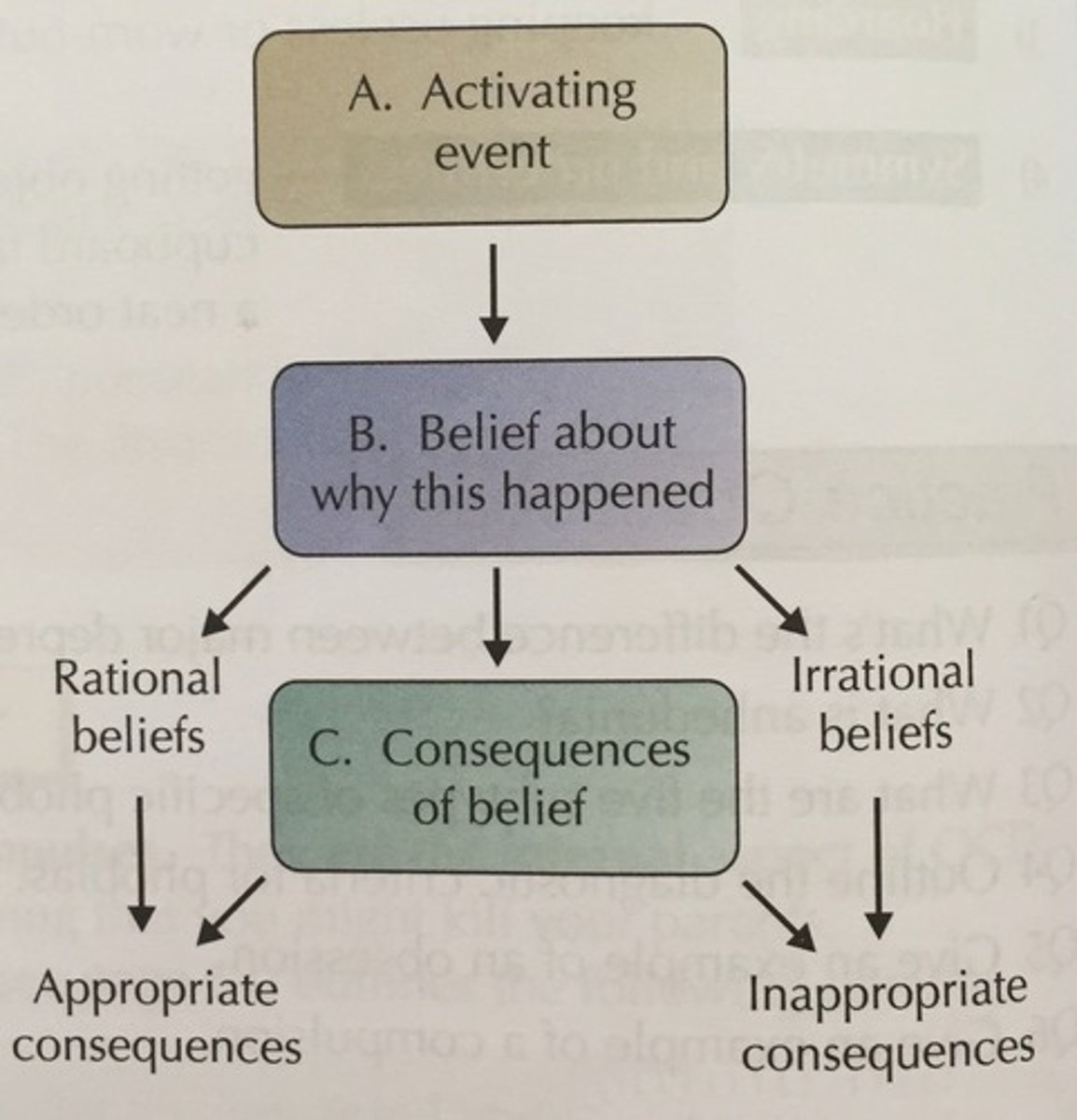
What are the goals of CBT?
1. Unlearn unwanted reactions and learn new behaviors
2. Challenge distorted thoughts about situations
3. Test out alternatives in the real world
What are the characteristics of CBT?
1. Thoughts cause feelings and behaviors
2. Brief and time-limited (average number of sessions = 16)
3. Emphasis is placed on current behavior (although history is used to identify thoughts/feelings/behaviors of current situation)
4. A collaborative effort between the therapist and the client
What are the client's roles in CBT?
1. Define goals
2. Express concerns
3. Give feedback
4. Learn and implement learning
5. Teaches the benefit of remaining calm or at least neutral when faced with difficult situations (If you are upset by your problems, you now have two problems: 1) the problem, and 2) your reaction to the problem)
6. Based on "rational thought" (facts vs. assumptions)
7. Structured and directive (based on the notion that maladaptive behaviors are the result of skill deficits)
8. Based on assumption that most emotional and behavioral reactions are learned (therefore, the goal of therapy is to help clients unlearn their unwanted reactions and to learn a new way of reacting)
10. Homework is a central feature of CBT (keeping a journal of thoughts, reflection of cognitive reappraisal, implementing learned skills)
What are the therapist's roles in CBT?
1. Help client define goals
2. Listen
3. Teach
4. Encourage
What are common CBT techniques?
1. Operant conditioning, positive reinforcement
2. Socratic questioning
3. Self-monitoring
4. Systematic desensitization
5. Behavioral experiments
6. Cognitive rehearsal
7. Assertiveness and social skills training
8. Activity scheduling/behavioral activation
9. Homework
Socratic Questioning
Asking probing questions about clients' irrational thoughts
Self-Monitoring
Observing and recording specific targets (thoughts, emotions, body feelings, and behaviors)
Systematic Desensitization
Form of exposure therapy (effective for phobias)
Behavioral Experiments
Planned experimental activities to test the validity of a belief
Cognitive Rehearsal
Instructed to imagine situations and rehearse positive thoughts
Assertiveness and Social Skills Training
Practice and modeling
Activity Scheduling/Behavioral Activation
Regularly engage in pleasant activities that may elevate mood
Homework
Structured therapeutic activities
Automatic Thoughts
Thoughts that occur spontaneously and are often used to describe problematic thoughts that maintain mental disorders
What are some examples of mindfulness-based treatments?
1. Mindfulness-Based Stress Reduction (MBSR)
2. Dialectical Behavioral Therapy (DBT)
3. Acceptance and Commitment Therapy (ACT)
What is the main goal of mindfulness approaches?
Mindfulness approaches aim to enhance clients' ability to recognize thought processes and detach from distressing thoughts/emotions through mindfulness exercises
Ex: Acceptance of current mood and thoughts
Humanistic Theory
Third wave in American psychology
Developed in the 1960s in opposition to psychoanalysis and behaviorism
Humanistic approaches focus on the fullest growth of an individual in the areas of love, fulfillment, self-worth, and autonomy
Assumes that all people are inherently good with potential to maintain healthy, meaningful relationships and to make choices that are in the best interest of oneself and others
What are the humanistic-existential approaches?
1. Person-Centered Therapy
2. Gestalt Therapy
3. Existential Therapy
Who are the humanistic-existential theorists, and why are they significant?
1. Frankl:
Logotherapy (meaning-making)/"Man's Search for Meaning"
2. Perls and Perls:
Co-founders of Gestalt Therapy
3. Yalom:
Four givens of the human condition: death, meaning, isolation, and freedom
4. Rogers:
Person-centered/effective functioning is brought about by living one's full experience
5. Johnson:
Emotion-focused therapy
6. Maslow:
Maslow's hierarchy of needs leading to self-actualization/emphasized the positive qualities in clients
7. Jenkins:
Humanistic approach to black psychology/resilience in the face of oppression
Person-Centered Therapy
Carl Rogers was the founder
Rejected psychoanalysis and behaviorism
Books:
"On Becoming a Person"
"Client-Centered Therapy"
"A Way of Being"
What are the mechanisms of change in person-centered therapy?
1. Self-healing and personal growth leads towards self-actualization
2. Therapy as a journey shared by two falliable people
3. People have an innate striving for self-actualization
4. Personal characteristics of therapist and the quality of therapeutic relationship
What are the three facilitative conditions in person-centered therapy?
1. Congruence (genuineness)
2. Unconditional positive regard
3. Empathy
Must have these and communicate them to the client
What are the dont's of person-centered therapy?
1. Evaluate
2. Interpret meaning
3. Question in a probing manner
4. Diagnose
5. Reassure
6. Criticize
7. Judge
8. Praise
9. Describe
Maslow's Hierarchy of Needs (Via Blackfoot Nation)
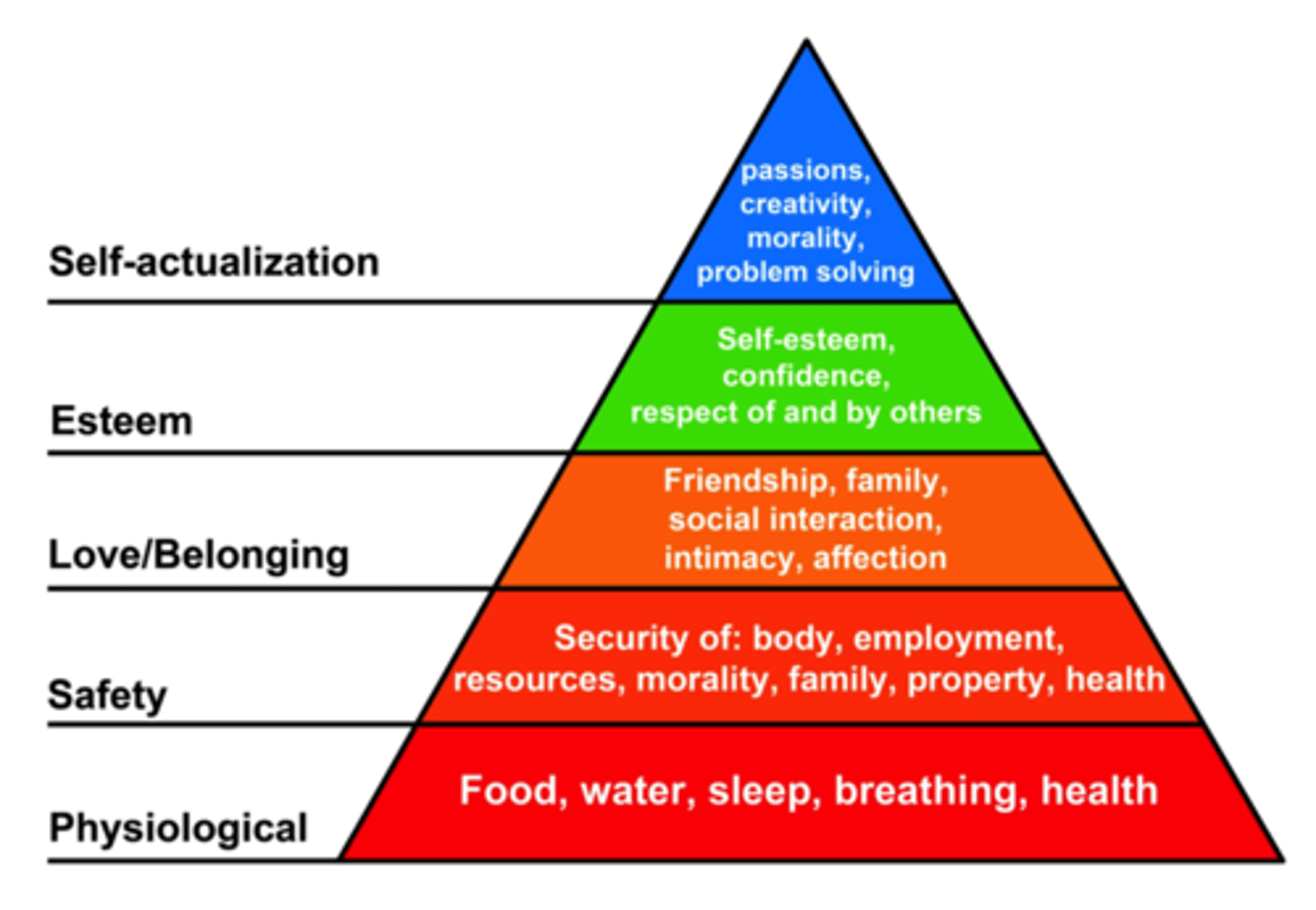
What are the takeaways of person-centered therapy?
1. Congruence (genuineness or realness)
2. Unconditional positive regard (acceptance and caring, but not approval of all behavior)
3. Accurate empathic understanding (ability to deeply grasp the client's subjective world)
4. Helper attitudes are more important than knowledge
5. Relationship is key
What are the Gloria Films, and what do they depict?
The Gloria Films depict three therapeutic approaches with a real client:
1. Rogers' Person-Centered Therapy
2. Perls' Gestalt Therapy
3. Ellis' Rational Emotive Behavior Therapy (REBT)
Gestalt Therapy
Fritz Perls was the founder
Rejected psychoanalysis
Self-knowledge
Acceptance
Growth by immersion in current existence
What are the mechanisms of change in gestalt therapy?
1. Experimental (works with client awareness and awareness skills)
2. Therapist and client in active engagement with each other
3. Integration of affective, cognitive, sensory, interpersonal, and behavioral
4. Holism/Field Theory
5. Organismic self-regulation
Holism/Field Theory
Person cannot be understood apart from their environment
Organismic Self-Regulation
Knowing and owning what one senses, feels emotionally, observes, needs, wants, and believes
What are the key concepts of gestalt therapy?
1. Contact
2. Conscious awareness
3. Experimentation
What are the practices of gestalt therapy?
1. Confrontation (naming discrepancies/incongruence)
2. Direct guidance (exercises and experiments in session)
3. Self-involving disclosures (here-and-now statements)
Existential Therapy
Kierkegaard, Nietzsche, Heidegger, Sartre
Each individual is responsible for giving meaning to life and to living authentically
What are the assumptions of existential therapy?
1. We have the freedom to choose our own circumstances
2. We are not victims
3. We create our own meaning in life
4. Mental illness originates from failure to be, to use one's power, and to act authentically
What are the four givens of the human condition?
1. Isolation
2. Meaning/meaninglessness
3. Mortality/death
4. Freedom
What are the takeaways of existential therapy?
1. Human need for meaning
2. Effective functioning via actualization of freedom
3. Inevitability of facing challenges in life (face/own vs. deny)
4. Subjective phenomenological flow of experiencing
5. Experiencing is imbedded in relationships
The Paradox of Belonging
1. The human paradox
2. The courage to be
3. Crisis of identity
4. Experience of aloneness
5. Experience of relatedness
The Human Paradox
We desire individual identity
We desire collective belonging
The Courage to Be
They will discover I am a fraud
They will not like the real me
Crisis of Identity
Where do I belong in the universe?
Experience of Aloneness
Before we can be in a relationship, we need a relationship with ourselves
Experience of Relatedness
Experience of Relatedness
What are some deep existential questions?
What does it all mean?
What is my purpose in life?
Whose life am I living?
Why am I here?
Is anything important?
How can new meaning be created?
1. Trauma
2. Developmental experiences
3. Values
4. Transitions
Meaning-Making, Values, and Intentionality
Finding a new "way to be" based on sense of priority
Finding meaning in suffering
Authentic Living
What is it that deeply drives us to do what we do?
Vitality and enjoyment
Inauthentic Living
Imposed duty, loss of capacity to make decisions
What are the goals for existential therapy?
1. To become more present with self and others
Authenticity, awareness, acceptance, expressiveness
2. To understand limits that block presence (both natural and self-imposed limits)
What limits are forced on client by external world?
What limits do clients place on themselves?
Accept the inevitability of some aspects of life (suffering happens)
3. To take responsibiliy for their choices (and their lives)
Identify things that clients can control/change and help them take responsibility for actions
4. To actualize ways of being
Confrontation of normal anxiety and ambiguity
Convert values and sense of responsibility to meaningful actions
What are the mechanisms of change in existential therapy?
1. Counselor's role is to facilitate confrontation of limitations, freedoms, and realities; facilitate ability to take responsibility; and urge clients to live creatively
2. Understanding of phenomenological worldview (does not provide answers or advice)
3. Importance of the therapeutic relationships (authentic relationships, allowing the client and therapist to become important to one another)
What is feminist psychotherapy?
The practice of therapy informed by feminist political philosophies and analysis, grounded in multicultural feminist scholarship on the psychology of women, men, and gender, which leads both therapist and client toward strategies and solutions advancing feminist resistance, transformation, and social change in daily personal life, and in the social, emotional, and political environments
Why is feminist psychotherapy important?
1. Feminist therapy is not just for women
2. Systemic oppression causes mental distress among marginalized groups
3. Feminist psychotherapy attempts to focus on marginalized viewpoints
4. The main goal is change, not just within the individual, but change in society
What is the key idea of feminist psychotherapy?
Feminist psychotherapy is a therapy focused on eliminating oppression, both internal and external, for all people, not just for women
What are the six major theoretical principles of feminist psychotherapy?
1. The personal is political
2. Personal and social identities are interdependent
3. Definitions of distress and mental illness are reformulated
4. Integrated analysis of oppression is used
5. Egalitarian relationship is important
6. Women's perspectives valued
What are the goals of feminist psychotherapy?
1. Increase awareness about one's gender role socialization process
2. Replace internalized gender role messages with more functional beliefs
3. Empower clients to bring about change in the environment
4. Develop a wide range of behaviors that are freely chosen
5. Become personally empowered
What are the strengths of feminist psychotherapy?
1. Gender-free, flexible, interactive
2. Works toward changes rather than adjusting to status quo
3. Pays attention to power dynamics
4. Avoid pathologizing clients
What are the limitations of feminist psychotherapy?
1. Requires shared values between clients and therapists
2. Requires balance between emphasizing societal factors and personal responsibility
3. Clients bear the responsibility to make decisions
4. Rare in medical settings
5. Leaves out voices of women with other marginalized identities
Intersectional Feminism
Explores intersection between race, class and gender
Kimberle Crenshaw is a law professor at UCLA and Columbia Law School
Intersection of gender and race, not only what is means to be a woman, but what it means to be a woman of color
"Intersectionality is a metaphor for understanding the ways that multiple forms of inequality or disadvantage sometimes compound themselves and create obstacles that often are not understood within conventional ways of thinking."
What are constructivist theories?
1. Humans are meaning-makers in their lives
2. Humans construct their own realities
3. Client is an active participant in creating and determining their life path
4. Differs from other theories that view reality as fixed and to be discovered; reality is something that is created
5. Close attention to client strengths
6. Client's resources, hopes, goals, and dreams are incorporated
Constructivist Theories and Therapy
1. Narrative therapy:
Clients master their lives through telling stories and re-authoring their lives
2. Solution-focused brief therapy:
Brief
Focus on strengths and solutions
"The Miracle Question"
3. Relational-cultural therapy:
Move toward mutually-growth-fostering relationships
4. Emotion-focused therapy:
Often with couples, safe and secure bond
Attachment theory, focus on emotions
Smith and Glass (1977)
Published one of the first meta-analyses on psychotherapy
Looked at 375 studies on psychoanalysis
The average person who went to therapy was doing better than 75% of the people who did not go to therapy